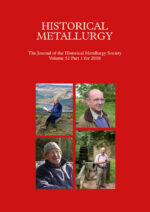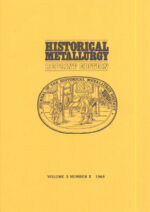Journal Contents
The contribution of Henry Clifton Sorby to the study of reflected light microscopy of iron and steel
C Hammond
Pages 1-8
‘When I commenced life as a young man I had the choice of either wisdom or riches, and resolved to content myself with moderation and devote myself to science”
Sorby’s own words, drafted for a speech of thanks following the award of a Gold Medal of the Royal Society in 1874, are perhaps most expressive of the character of the man and the tenor of his life: sober, dispassionate, isolated and devoted to science as such, the corollary of enhghtenment and progress !
Henry Clifton Sorby is one of those figures in the history of science whose particular genius or talent would not, perhaps, have found the same measure of fulfilment at a different stage of scientific development or in a different social climate from that in which he lived. He was bom in 1826 into a prosperous Sheffield family which owned a long-established edge tool manufacturing firm. This, and judicious family investments, provided him with a degree of independence and sufficient income to purchase equipment for his scientific research equal to the most technically advanced then available, such that by the time of his father’s death, when he was 21, he already had a room in the family house set aside as a laboratory’and which was to remain so throughout his life.
White copper: The arsenical coinage of the Libyan revolt 241-238 BC
Susan L a Niece and Ian Carradice
Pages 9-15
Arsenic-copper alloys are not common after the Early Bronze Age. The discovery of a group of 3rd century BC coins, probably from Timisia, with surface metal composition of up to 29% arsenic in the copper prompted this metallurgical examination. The arsenic was found to occur in greatest concentration on the coin surfaces as the result of inverse segregation during casting.
Old Kingdom copper smelting artifacts from Buhen in Upper Egypt
El Sayed E l Gayar and M P Jones
Pages 16-25
Artefacts from an early copper smelter were collected during an archaeological investigation of the Old Kingdom town of Buhen in Upper Egypt. These artefacts include fragments of copper ore, prills of copper metal, and pieces of the furnace walls, and they have been studied using modern analytical procedures.
The copper metal is generally of high purity but its most distinctive feature (like that of the accompanying ore specimens) is its exceptionally high gold content. In addition, the copper metal and the ore specimens have been partly altered to copper chloride.
The mineralogical features of the smelting furnace indicate that the temperature achieved in the hottest (vitrified) portion of the furnace may have been as high as 1200°C. However, the presence of virtually unaltered clay minerals in one fragment of furnace wall shows conclusively that the temperature in some parts of the furnace wall did not exceed 250°C.
Pieces of slag, some of which are trapped within the copper metal and others which are attached to the furnace wall, contain fayalite, vmstite, and magnetite crystallites which are enclosed in a calcium-bearing, iron-silicate glass. The iron content of the smelting slag is variable but averages over 13 percent; this suggests than an iron-rich flux had been used during the smelting operation. This slag also contains an average of about 8 percent copper which occurs as numerous small globules of the almost pure metal.
Two thousand years of coinage in China: An analytical survey
S G E Bowman, M R Cowell and J Cribb
Pages 25-30
Tlie primary aim of this project was to provide an analytical survey of dated copper-based Chinese cast metalwork. The potential of coinage for this purpose is obvious and, in the case of China, made particularly opportune by the long tradition of manufacture of the copper-alloy cash coin. For almost two millennia the Chinese used this copper-based unit as virtually their only official coinage for day-to-day use. For much of this time the style and method of production of the cash remained essentially unchanged (1). Unlike the majority of Western coinages it was cast in its final form, instead of being struck, and this practice continued right up to the early 20th century.
A new Late Bronze Age weapon hoard from the Guadalquivir River in the Province of Seville, Spain
M M Ruiz-Delgado and M A Hunt-Ortiz
Pages 31-34
The increasing number of Late Bronze Age finds appearing in the southern part of the Iberian Peninsula, both isolated and in hoards, suggests the need for a new approach to the economic role of bronze metallurgy in this region^ Since the discovery of the well known hoard from the Huelva estuary in 1923, many new metallurgical finds have been reported. Most of them have been found without any clear archaeological context and frequently without a clear geographical location, since many of them are in private collections. The best documented find with a precise chronological context is the very interesting carp’s tongue sword found in the stratigraphic section of the excavation at the Cerro de la Miel (Moraleda de Zafayona, prov. Granada), published recently. We can add another hoard discovered in the Guadalquivir river, which is the subject of this note.
The provenance of tin metal in workings for alluvial cassiterite in Nigeria
Denys E S King
Pages 35-40
Beads of metallic tin were not infrequently found in workings for cassiterite at the northern end of the Plateau minesfield, and it was commonly believed that these were artifacts and that their presence could be attributed to the intercourse between the tribes inhabiting this part of the highlands and traders from Badiko and Liruein Delma, where it is known that the smelting of tin had been practised long before the arrival of the first Europeans.
From what the writer remembers of these beads, they were generally more or less spherical, 4 or 5mm diameter, usually imperforate but often with one minute hole in them and apparently hollow, and in the Hght of his later investigations he considers that for the most part they were not artifacts but had been produced in the process of the smelting of iron.
Close plating: A Black Country silver plating process
Reg Morton and Michael Hallett
Pages 41-
This paper is mainly the result of work done by Reg Morton and his colleagues and was given to Michael Hallett for completion upon his death. Michael had hoped to do more work on the process which was widely used in the Walsall area but unfortunately died before this could be done (Hon Ed).
In one process of close plating, the object to be plated, usually a copper-base alloy, was heated and tinned all over. While the tin was still molten pieces of sheet silver were wrapped around it and gently peened into place. A large part of the skill was the cutting of the sheet into pieces that would exactly fit against each other when wrapped around a curved and sometimes ornate object. The main advantage was that a much thicker silver plating could be applied than by electro-plating. The process was especially popular for carriage fittings and for coffin furniture. There was another process which we cannot recollect but which was carried out at a lower temperature than the one discussed here.
The process has been described in Lardner’s Cabinet Cyclopaedia of 1833, an excerpt from which is given in the Appendix. The work investigated here was supplied by J Cotterell and Sons Ltd, of Littleton St, Walsall, Staffs. The firm is an old established manufactory of horse furniture and the samples were of 19th century manufacture. The process is no longer used by the company.






There are no reviews yet.